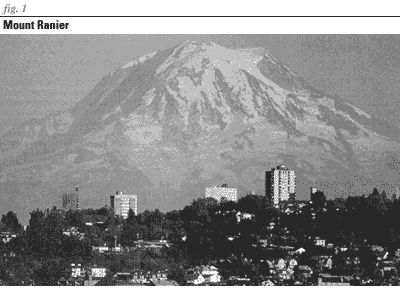Lesson 6: Volcanoes and People
 |
| Fig 1: Snow-capped Mount Rainier rises behind Tacoma, Washington, Although Mount Rainier has not erupted in the past years, scientists consider it one of the most hazardous volcanoes in the Cascade Range. |
Relative to other types of natural disasters, such as earthquakes, floods, hurricanes, and tornados, volcanic eruptions occur infrequently. Of the 1,500 active volcanoes on land, approximately 50-60 erupt each year. Approximately 1 million people have been killed by volcanic eruptions during the past 2,000 year.
United States Has Many Active Volcanoes
Because many of the most hazardous volcanoes have not erupted during recent historic times, people erroneously consider them extinct. For Mount St. Helens, more than a century had elapsed since a major eruption; most people were not aware of its dangers. Mount St. Helens is one of more than 65 active or potentially active volcanoes in the continental United States, Alaska, and Hawaii. Only Indonesia and Japan have more!
Scientists of the U.S. Geological Survey continue to monitor Mount St. Helens and other volcanoes in the Cascade Range. They know from its past eruptive history that many of Mount St. Helens' eruptions have occurred in concentrated periods of time lasting decades or even centuries. For example, one eruptive phase began in 1480 and lasted for about 300 years. Based on that history, scientists anticipate that Mount St. Helens will continue to erupt episodically for decades to come before it returns to a dormant stage.
The eruption of Mount St. Helens served as a reminder that other dormant volcanoes can come to life again. Mount Shasta in Northern California, for example, probably last erupted in 1786. On a geological time scale, this very recent volcanic activity suggests that magma is still present beneath the volcano. On average, it has erupted once every 300 years over the past 3,500 years. The chance is 1 in 25 to 30 that it will erupt in any one decade and 1 in 3 or 4 within a person's lifetime.
Forecasting Future Eruptions
Scientists have improved their ability to predict the time of a volcanic eruption, but estimating the size and style of an eruption remains a difficult challenge. Despite this challenge, scientists try to assess the potential consequences of a future eruption by reconstructing a volcano's history, which includes the pattern, magnitude, and frequency of its past eruptions. The principal means of developing this history is by mapping and dating the different types of volcanic materials that have been deposited by previous eruptions. Assembled into volcanic hazards maps, this information is vital for communities in volcanically active areas to use for land use and emergency preparedness planning. Knowing a volcano's past is crucial to forecasting its future behavior.
 |
| Fig 2: Cascade Eruptions Chart. Eruptions in the Cascades have occurred at an average rate of one to two per century during the last 4,000 years. Four of those eruptions would have caused considerable damage and loss of life if they had occurred today without warning. |
Benefits Often Overlooked
Because of the destructive nature of a volcanic eruption, we tend to overlook a volcano's benefits. Magma circulates and deposits many valuable elements, such as gold, silver, zinc, sulfur, and copper. Magma heats ground water systems that can be tapped to produce geothermal power. This heated ground water can also result in geysers and hot springs. Volcanoes are also responsible for some of the world's most fertile soils. And volcanoes continuously bring materials from inside the Earth to the surface—recycling on a grand scale.
|